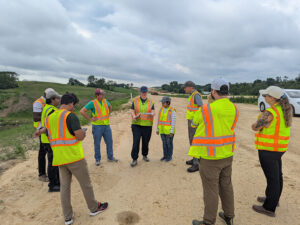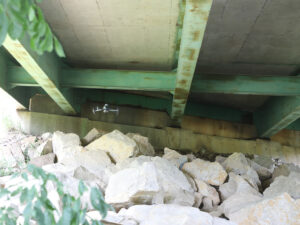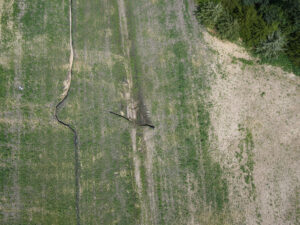InTrans / Jul 28, 2025
Piloting sUAS: PROSPER project demonstrates drone deployments useful to local transportation agencies

A sunny, clear day with a moderate high temperature in mid-July is just about a perfect summer day in Iowa. Three of those days in a row is a marvel.
For Program for Sustainable Pavement Engineering and Research (PROSPER) Director Halil Ceylan and his small unmanned aircraft system (sUAS) research team, the perfect weather was not an excuse for a vacation day but rather an opportunity to collect large sums of data for three in-progress pilot studies as part of a larger Iowa Department of Transportation (DOT) project.
The itinerary for the three-day field trip took the PROSPER research team, including subcontractors from the Michigan Tech Research Institute at Michigan Technological University, to inspect a bridge deck at Littleton in Buchanan County and erosion control measures at Mediapolis in Des Moines County. The team included six Federal Aviation Administration (FAA)-certified sUAS pilots and was led by the remote pilot in command, Abdullah Sourav.
“The objective of the overall project is to develop, test, and demonstrate how sUAS technology can be deployed and implemented in various transportation- and infrastructure-related work of interest to the Iowa DOT and local road agencies,” Ceylan said.

Ceylan is a renowned expert in sUAS use in transportation, serving as the Iowa State University site director for the FAA Partnership to Enhance General Aviation Safety, Accessibility and Sustainability Center of Excellence on General Aviation and previously led a similar but national-level, federally funded FAA project that collected sUAS data from six airports. Ceylan is also the founding chair of the American Society of Civil Engineers (ASCE) Transportation & Development Institute Uncrewed Aircraft Systems Committee and currently leading two FAA projects to evaluate the use of sUAS and machine learning for airfield pavement inspection and to develop related guidelines to be adopted by government agencies and industries.
Details on the data collected in mid-July using multiple sUAS are as follows:
- Bridge Deck Delamination Inspection: The team investigated, identified, and measured the extent of spall and delamination on the Perry Bridge deck in Littleton using red green blue (RGB) high-resolution images collected using a Freefly Astro sUAS carrying a Sony LR1 61-mp camera in addition to conducting a traditional drag chain test as a comparison. Freefly Astro is one of the very few National Defense Authorization Act (NDAA)-compliant and approved for U.S. Department of Defense use sUAS. Thermal and multispectral data of the bridge deck were also collected using a Mavic 2 Enterprise Advanced and Mavic 3 Multispectral, respectively.
- Bridge Digital Twin Construction: The team collected overlapping RGB images from the top and side of the Perry Bridge section to construct a digital twin.
- Soil Erosion Control Measure Inspection: The team inspected and monitored erosion and sediment control devices throughout Des Moines County, seeking regions of damage and assessing current condition for intended use and regulation compliance, by collecting multispectral, thermal, and RGB image data using a Freefly Astro with Sony LR1, Mavic 2 Enterprise Advanced, and Mavic 3 Multispectral.

One of the five anticipated pilot project studies that will be conducted as part of the sUAS project has already been completed and focused on the detection of fine hairline cracks on bridge decks. Another pilot project focusing on the use of sUAS for gravel road inspection is at the final stage of completion.
“The pilot project studies allow us to investigate and demonstrate a variety of sUAS-based approaches to ensure long-term successful implementation of these practices,” Ceylan said.
Ultimately, final products from the overall project, which is expected to wrap up in summer 2027, will include best practices guides and technical references for the Iowa DOT and local agencies to use when selecting and using sUAS platforms, sensor technologies and systems, and data processing methods in their work.
“Our hope is that the results of this project, and all its pilot studies, will provide Iowa counties and cities and the Iowa DOT with expedited, efficient, and cost-effective ways for building and managing their transportation infrastructure assets while increasing safety and decreasing cost,” Ceylan said.
Learn more about the project and the pilot studies at the research project page.
